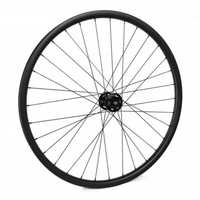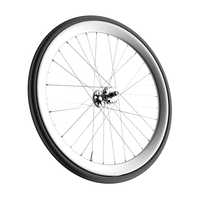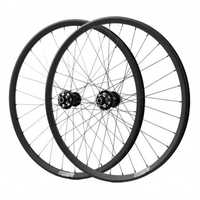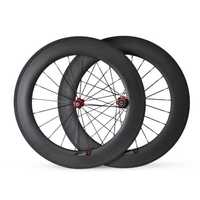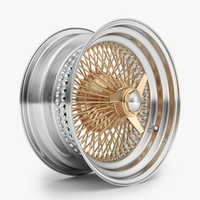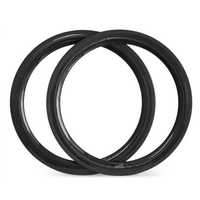All You Need to Know About Bicycle Wheel
After the bike frame itself, wheels are one of the most crucial parts of your bicycle. Because of this, adding wheels to your bike is one of the best investments you can make. All bicycle wheels eventually need to be changed, in addition to the necessity for an update. Depending on your weight, the road or trail conditions, the total weight of your bike, how aggressively you ride, anda most importantlya how much braking you perform, replacement mileage may range from thousands of kilometres to lakhs or more.
Why Are Good Wheels Important?
Nothing compares to a nice pair of shoes. Similar principles apply to bicycle wheels; a good wheelset may improve the appearance, comfort, durability, and speed of your bike. The worth of your bike may be increased by changing your wheelset, but it's crucial to know what constitutes a good wheelset and also what advantages come with upgrading. You'll be prepared to assault your next race if you have the appropriate pair of wheels. Your bike's greatest qualities might be enhanced with a decent pair of wheels.
A higher-quality wheelset often results in lighter wheels with less rotational weight, better acceleration, and an advantage in overall speed. Off-road riding, for example, need sturdy, robust wheels that can withstand a lot of abuse and yet roll true. A nice wheel is a matter of opinion. A great wheel is one that satisfies the requirements and demands of the specific rider, to put it another way. However, it's obviously more difficult than that. Your spending limit, body weight, and the intended use for each wheel are factors that you must consider. Your perfect wheelset should be affordable and provide the right ratio of longevity, lightweight, and strength for your favourite riding sport.
Characteristics Of a Good Bicycle Wheel
The characteristics that people look in a good cycle are:
Durability: Numerous variables affect the durability of bicycle wheels, including:
- spoke count
- rim substance
- spoke tension
- Lacing pattern
- Hub flanges
The spokes and rim provide the majority of a wheel's strength. The quality of the wheel construction is significantly more crucial for having a solid, long-lasting wheel than the quality of the components. When it comes to how the wheels are supposed to be used, you must decide what is most important. We require wheels that are somewhat sturdy while yet being lightweight for efficiency since the roads in India aren't in the finest condition. On competitive road wheels, the spoke count typically ranges from 16 to 32 up front and 18 to 34 down back. The wheel is lighter, but necessarily weaker, the less spokes it has. The wheel becomes heavier and stronger as the number of spokes increases. Don't think that lightweight performance wheels are "weak" since wheel construction technology has advanced significantly. Just that a stiffer wheel often has a higher spoke count.
Structure: A bicycle wheel is designed to be compliant and strong enough to transmit power effectively. Let's not conflate a wheel's capacity to deliver comfort with compliance.
Comfort is not often the main goal of wheel design. For comfort, you must focus on the seat post, saddle, frame, cycling shorts, etc. rather than the wheels. The wheels may be as sturdy as possible while also not acting as shock absorbers. Only wheels with spoke pressure which is too low to ensure effective power transmission and a robust, long-lasting wheel will feel too bouncy. Your wheel's rigidity is affected by a few different factors. A wheel becomes both radially and laterally stiffer as it has more and thicker spokes. In terms of rims, radial stiffness is more influenced by rim depth, while lateral stiffness is more influenced by rim width. The wheels that give high performance increases and are often quite durable are those that are moderately stiff.
Aerodynamics: In the realm of road bike, aerodynamic elements are mainly advantageous and prominent. Although some Cross-Country MTB wheels contain aero characteristics like bladed spokes, their importance isn't as great. Aerodynamic wheels are often thought to be exclusive to racers or really fast riders. The fact is that reducing wind resistance begins to pay off handsomely even at speeds as low as 30Kph. Therefore, switching to more aerodynamic wheels makes sense for all forms of road riding, including cruising, criteriums, and century tours. There are several variations of aero wheels. Track riders often utilise deep-section wheels for optimal aerodynamics. But keep in mind that more rim depth and, thus, more surface area are required to make a wheel more aerodynamic; for this reason alone, aero wheels often weigh more.
Accessibility: Whatever you pay for, you get. Like with most things, you receive greater value for your money when you spend more. Undoubtedly, the more costly wheels will be stronger, lighter, and more effective.
Weight: Another significant element that road riders place a lot of emphasis on is weight. Lighter wheels are advantageous, particularly while climbing. With lighter wheels, your bike will be lighter overall, requiring less effort to move. A performance improvement of 200a 500 grammes over your present wheels may be felt. The distribution of weight on the wheel may also have an impact on how well it performs. It is more difficult to move wheels that have a higher proportion of their weight near the rim. Conversely, wheels that have more of their weight at the hub and less of it at the rim will feel more responsive. More energy may be saved by reducing the mass of the wheels, particularly the rims and tyres, than by significantly reducing the mass of the bicycle or rider.
Bicycle Wheel Anatomy
The anatomy of the bicycle wheel contains:
Rims: The core of a wheel is its rim. The rim performs the crucial purpose of keeping the tyre to the wheel in addition to acting as the anchor for spoke heads, also known as nipples. Rims may be constructed from a variety of substances, including steel, aluminium, and carbon fibre. The perfect rim is trustworthy and long-lasting, robust where it's required, but flexible enough to deflect impacts.
Hubs: Another component of the wheel that is crucial is the hub. Hubs hold the spokes and are attached to the fork or frame. It is made up of a flange, bearings, and an axle. In addition to being lightweight, a high-quality hub will contain superior internal parts, such as friction-reducing high-quality bearings. Additionally, the hubs need to be adequately protected from the weather. The calibre of the hub's bearings determines how good the hub is. Hub bearings typically come in two varieties: sealed/cartridge bearings and cup & cone systems. Cartridge bearings cannot be serviced, although cup and cone bearings can. Every so often, it's a good idea to disassemble the cups and cones that keep the bearings in place to inspect them for wear and damage. Overtightening and grime are these bearings' worst enemies.
Axles: Taken to be a part of the hub is the axle. It secures the wheel and hub to the bicycle frame. The "rapid release" axle mechanism often enables easy replacement of the wheel. Some motorcycles include a bolt that makes them more secure, such as single-gear or stunt bikes. Make a note of the size of your axles if you're thinking about changing them since axle sizes vary. The term "thru-axle" refers to a sort of recently developed axle. The thru-axle is simply a thicker, stronger, and more rigid axle than conventional axles.
Nipples And Spokes: The metallic wires that link the rims to the hub are called spokes. They may be constructed from a variety of materials, including carbon fibre, stainless steel, and aluminium. They may also have various designs. The right lateral and radial wheel form requires that spokes be under a specified tension at all times. The nipple, which connects the spoke to the rim, is where stress is managed. The components known as nibbles are what attach the spoke to the rim. They are the component that will regulate spoke tension and must be tightened or loosened using a spoke tool. For strength, spokes are often "laced" such that they cross one another close to the hub. The cross may be four times, three times, twice, or maybe not at all (usually on the front wheel). Stronger, the more crosses there are. However, additional crosses will result in longer spokes, which will add weight to the wheel. An average conventional wheel has 34a 36 spokes, however this number might vary. There are several contemporary wheels with just 14a 16 spokes.
When To Replace Bicycle Wheels?
Here are a few explanations for why you might want to get new wheels:
- The main cause is often impact damage. This may take the form of flare hits, flat areas, or tacoed rims. These are often extremely obvious and have a significant impact on performance.
- The usage of a rim type brake for a lengthy period of time leads to brake wear. The sidewall of the rim's metal actually gets too thin to withstand the pressure of an inflated tyre when enough metal is literally worn away from it. This is unusual since rims often deteriorate from damage before becoming unsafe, but it should be replaced. On more recent rims, there are indicators that let you know this is occurring.
- Another frequent problem is spoke fatigue. The repeated application and removal of stress to a wheel's spokes will wear down the metal until it breaks. In most cases, spoke breakage occur within a short amount of time. More than three broken spokes should raise red flags.
FAQs: Bicycle Wheel
Question: What are the different types of bicycle wheels?
Answer: Some bicycle wheel types are:
- Tubeless road bike wheels.
- Clincher road bike wheels.
- Road wheel braking surfaces.
- Mid-section wheels.
- Shallow Section wheels.
Question: What is the wheel size of bicycle?
Answer: 622mm diameter rims are used by most bicycles.
Question: What is the price of cycle wheels?
Answer: The price can start around 400 rupees, and increase based on the quality.
Question: Why Spokes Are Used in Bicycle Wheels?
Answer: The weight of the wheel is focused at its rim thanks to the spokes' connection to the axle in its centre.
